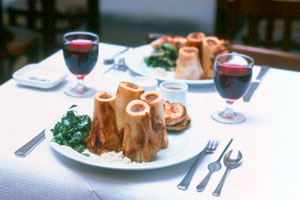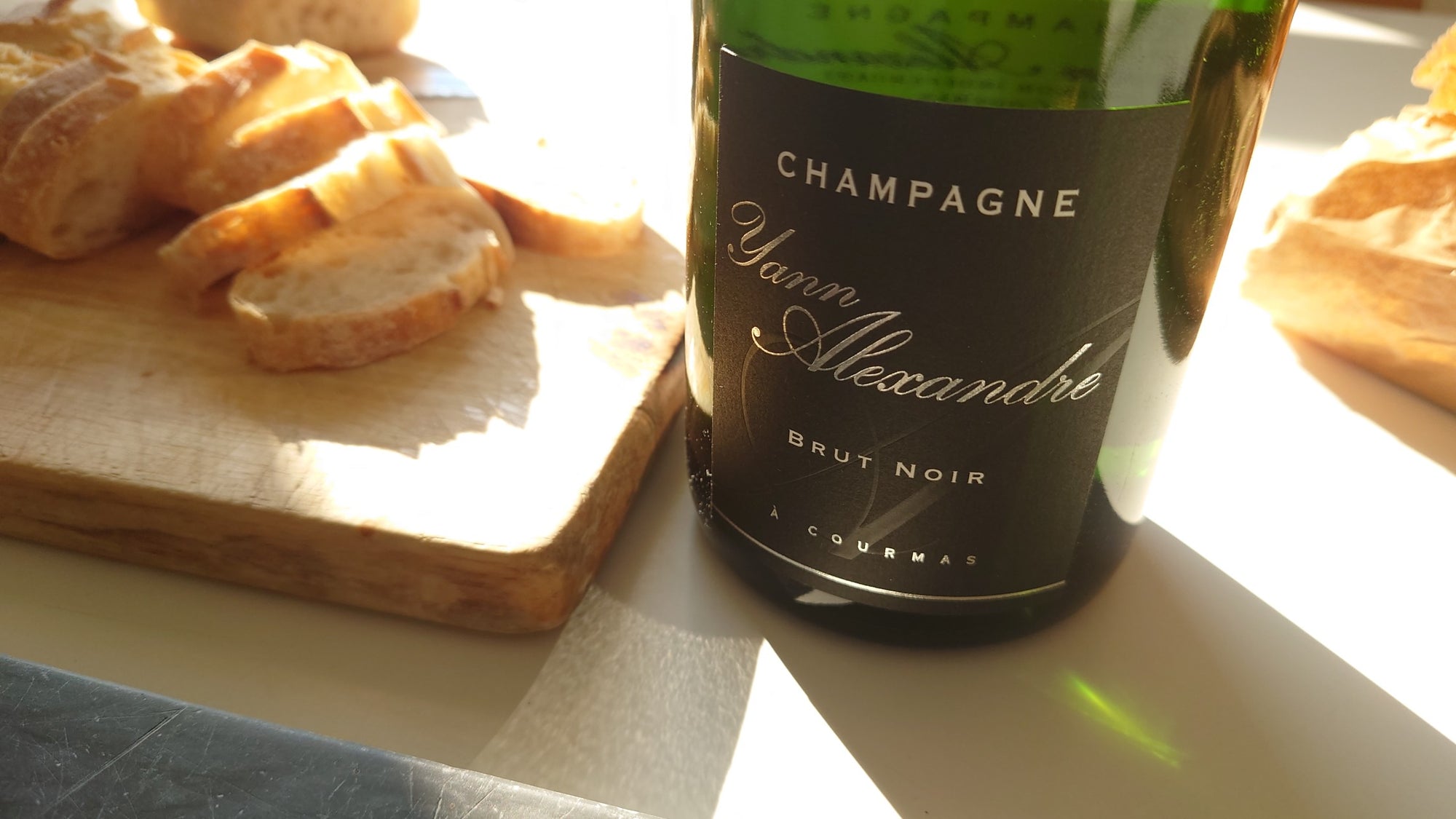
We went to
St. John to eat odd parts of animals. Luckily I was accompanied by the only physician in the family, Dr. Fred Frank. St. John is Chef Fergus Henderson’s showcase of “eating head to tail” a literally holistic approach to eating meat. He’s been embraced by the Slow Food movement as a cult hero for his culinary philosophy. It’s basically about respect for the animals that are eaten by ensuring they have a happy life and by not wasting normally discarded parts of their bodies. You can read more about it in his book
Eating Head to Tail.

The space is minimal and fairly industrial; one part gallery, one part abattoir and one part medieval food hall. The chef originally trained as an architect and the environment he’s created seems to fit the menu fairly well. We started with drinks at the bar, which also looks like a good place for an after work drink and a light supper. There we discussed such erudite topics as London real estate prices and why people don’t eat liver anymore over a bottle of
2003 Cuvee Anderena Irouleguy Blanc; a medium-full bodied, surprisingly deep yellow, fresh and lemony white that also served us well into our first course. The only complaint I really have with St. John is that most of their wines are served in water goblets, but at over ₤35 price per bottle you actually get a real wine glass. Note to St. John: stop this nonsense!

It’s a real treat to have a good waiter. He was unpretentious, friendly, efficient and unlike many US waiters he didn’t give his name; an excellent ambassador for the restaurant. His recommendations for first-timers were Roast Bone Marrow & Parsley and Lamb’s Tongues & Greens for starters and Calf’s Kidneys and Pig’s Intestines (they had better names on the menu) for main courses. Just as the old waiter’s cliché goes, everything was good. Outstanding were the Marrow, which was perfectly cooked and succulent on toast, and Intestines, which tasted like a tender sweet juicy ham. The kidneys, a staple in British cooking, were a little difficult for the Americans at the table. By the time we reached the main courses we had moved on to a
2002 Arnoux Père et Fils “Les Confrelins” Chorey-lès-Beaune, a rich, unpretentious, moderately fruity red Burgundy that found its way into real wine glasses. All the food was English, locally sourced from organic farms (not nearby Smithfield’s meat market), while the excellent wine list is all French. Dessert was an excellent and rich chocolate pot topped off with one of the few wines that can accompany chocolate, a
2003 Domaine Boudau Rivesaltes sur Grains. All in all a great experience; I can easily see why this is Nick Lander’s - the Financial Times food editor -favorite restaurant.
St. JOHN BAR & RESTAURANT
26 St. John Street, London EC1M 4AY.
Tel. 020 7251 0848 Fax. 020 7251 4090 Office. 020 7251 4080
*Offal is actually banned for human consumption in the UK and very sorry about the dumb pun.
 We went to St. John to eat odd parts of animals. Luckily I was accompanied by the only physician in the family, Dr. Fred Frank. St. John is Chef Fergus Henderson’s showcase of “eating head to tail” a literally holistic approach to eating meat. He’s been embraced by the Slow Food movement as a cult hero for his culinary philosophy. It’s basically about respect for the animals that are eaten by ensuring they have a happy life and by not wasting normally discarded parts of their bodies. You can read more about it in his book Eating Head to Tail.
We went to St. John to eat odd parts of animals. Luckily I was accompanied by the only physician in the family, Dr. Fred Frank. St. John is Chef Fergus Henderson’s showcase of “eating head to tail” a literally holistic approach to eating meat. He’s been embraced by the Slow Food movement as a cult hero for his culinary philosophy. It’s basically about respect for the animals that are eaten by ensuring they have a happy life and by not wasting normally discarded parts of their bodies. You can read more about it in his book Eating Head to Tail.
 The space is minimal and fairly industrial; one part gallery, one part abattoir and one part medieval food hall. The chef originally trained as an architect and the environment he’s created seems to fit the menu fairly well. We started with drinks at the bar, which also looks like a good place for an after work drink and a light supper. There we discussed such erudite topics as London real estate prices and why people don’t eat liver anymore over a bottle of 2003 Cuvee Anderena Irouleguy Blanc; a medium-full bodied, surprisingly deep yellow, fresh and lemony white that also served us well into our first course. The only complaint I really have with St. John is that most of their wines are served in water goblets, but at over ₤35 price per bottle you actually get a real wine glass. Note to St. John: stop this nonsense!
The space is minimal and fairly industrial; one part gallery, one part abattoir and one part medieval food hall. The chef originally trained as an architect and the environment he’s created seems to fit the menu fairly well. We started with drinks at the bar, which also looks like a good place for an after work drink and a light supper. There we discussed such erudite topics as London real estate prices and why people don’t eat liver anymore over a bottle of 2003 Cuvee Anderena Irouleguy Blanc; a medium-full bodied, surprisingly deep yellow, fresh and lemony white that also served us well into our first course. The only complaint I really have with St. John is that most of their wines are served in water goblets, but at over ₤35 price per bottle you actually get a real wine glass. Note to St. John: stop this nonsense!
 It’s a real treat to have a good waiter. He was unpretentious, friendly, efficient and unlike many US waiters he didn’t give his name; an excellent ambassador for the restaurant. His recommendations for first-timers were Roast Bone Marrow & Parsley and Lamb’s Tongues & Greens for starters and Calf’s Kidneys and Pig’s Intestines (they had better names on the menu) for main courses. Just as the old waiter’s cliché goes, everything was good. Outstanding were the Marrow, which was perfectly cooked and succulent on toast, and Intestines, which tasted like a tender sweet juicy ham. The kidneys, a staple in British cooking, were a little difficult for the Americans at the table. By the time we reached the main courses we had moved on to a 2002 Arnoux Père et Fils “Les Confrelins” Chorey-lès-Beaune, a rich, unpretentious, moderately fruity red Burgundy that found its way into real wine glasses. All the food was English, locally sourced from organic farms (not nearby Smithfield’s meat market), while the excellent wine list is all French. Dessert was an excellent and rich chocolate pot topped off with one of the few wines that can accompany chocolate, a 2003 Domaine Boudau Rivesaltes sur Grains. All in all a great experience; I can easily see why this is Nick Lander’s - the Financial Times food editor -favorite restaurant.
St. JOHN BAR & RESTAURANT
26 St. John Street, London EC1M 4AY.
Tel. 020 7251 0848 Fax. 020 7251 4090 Office. 020 7251 4080
*Offal is actually banned for human consumption in the UK and very sorry about the dumb pun.
It’s a real treat to have a good waiter. He was unpretentious, friendly, efficient and unlike many US waiters he didn’t give his name; an excellent ambassador for the restaurant. His recommendations for first-timers were Roast Bone Marrow & Parsley and Lamb’s Tongues & Greens for starters and Calf’s Kidneys and Pig’s Intestines (they had better names on the menu) for main courses. Just as the old waiter’s cliché goes, everything was good. Outstanding were the Marrow, which was perfectly cooked and succulent on toast, and Intestines, which tasted like a tender sweet juicy ham. The kidneys, a staple in British cooking, were a little difficult for the Americans at the table. By the time we reached the main courses we had moved on to a 2002 Arnoux Père et Fils “Les Confrelins” Chorey-lès-Beaune, a rich, unpretentious, moderately fruity red Burgundy that found its way into real wine glasses. All the food was English, locally sourced from organic farms (not nearby Smithfield’s meat market), while the excellent wine list is all French. Dessert was an excellent and rich chocolate pot topped off with one of the few wines that can accompany chocolate, a 2003 Domaine Boudau Rivesaltes sur Grains. All in all a great experience; I can easily see why this is Nick Lander’s - the Financial Times food editor -favorite restaurant.
St. JOHN BAR & RESTAURANT
26 St. John Street, London EC1M 4AY.
Tel. 020 7251 0848 Fax. 020 7251 4090 Office. 020 7251 4080
*Offal is actually banned for human consumption in the UK and very sorry about the dumb pun.


Comments
[…] Actually I think the British unfairly get a bad rap for their food. There’s a great culinary tradition that exists cheek by jowl with a fairly bad restaurant tradition. Let’s face it the popular conception of grey meats and khaki-coloured vegetables drenched in an unnameable industrial gravy had to have started somewhere. Sure, there are some great restaurants like The Fat Duck that duels with Spain’s El Bulli for top honors as the best restaurant in the world, but your average London pub still isn’t a great ambassador of cuisine. Great traditional British cooking is mainly found in homes (like my in-laws!) or in better gastropubs or restaurants like St. John. […]
Oh my goodness! a tremendous article dude. Thanks Nevertheless I’m experiencing subject with ur rss . Don’t know why Unable to subscribe to it. Is there anyone getting equivalent rss drawback? Anyone who is aware of kindly respond. Thnkx
As well as considered adding more videos for the web site posts to preserve the readers more entertained? I would recommend Someone said car write-up of yours and it was fairly good but as I%u2019m much more of a visible learner,I observed that being more helpful well allow me to understand how it turns out! I enjoy what you guys are always up as well. These clever function and reporting! Preserve inside the wonderful works guys I’ve added you guys to my blogroll. This can be a excellent report thank you for sharing this informative details.. Let me call at your weblog regularly for a few latest post.